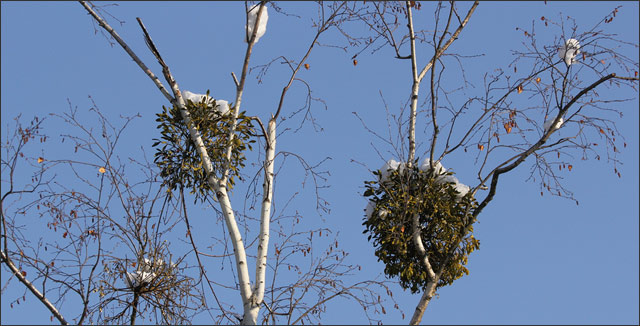
The Mysterious Mistletoe: From Folklore to Cancer Treatment

What is the deal with mistletoe? Why is it hung in a ball shape and why do people kiss underneath it?
I have to admit, I loved the idea of getting caught under this mysterious plant as a young person with someone I wanted very much to kiss. However, I never questioned the logic or lore of this practice.
It turns out mistletoe has not only an interesting place among world legends but also some exciting properties and an important ecological function!
Mistletoe Lore
If you’ve never seen real mistletoe or if you’ve never seen mistletoe in nature, you might be surprised to find out that it grows in the ball form you see hanging in doorways at Christmas time.
It stays green all winter, and it’s a parasitic plant that lodges high on deciduous tree branches – fruit trees, maples, and oaks – so when other trees are bare, these large balls of mistletoe hang around like a winter decoration.

Wild misteltoe growing in trees
It does have the characteristic white berries you see on the fake version, and when it flowers in summer, it sports yellow flowers.
The white berries, which drop easily, are highly toxic to humans and they get carried to new trees by birds, who eat the berries and leave the seeds in high branches along with their droppings.
Hence the name: “dung-on-a-twig.” the Anglo-Saxon word, “mistel” means “dung” and “tan” means “twig,”
Mistletoe Myths & Legends
Because of its unusual properties, mistletoe has been noticed for centuries and even put into the myths and legends of several regions around the world.
According to Norse legend, Frigga, the goddess of love, forgot to include mistletoe when she made all living things swear an oath not to harm her son Balder, who was the god of innocence and light.
When Loki, the god of evil and destruction, learned of her error, he tricked Hoth, Balder’s blind brother, into shooting an arrow made of mistletoe and guided it so it would kill Balder.
Balder’s death brought about the long winter nights in the north. When Frigga’s tears fell onto the mistletoe, they became the white berries, and she decreed that mistletoe should never again be the cause of harm but instead promote peace and love.
Anyone standing under the mistletoe was obliged to kiss – even if they were mortal enemies. The mistletoe meant they had to declare a truce for the day and lay down their weapons.
Not a bad story for the holidays, right?
Over on the British Isles, the Druid priests believed mistletoe to be a sacred plant because it didn’t put down roots in the ground.
If they found it growing on an oak – their most sacred tree – they considered it the soul of the tree. Druid priests would cut it down with a golden sickle on the 6th night of the new moon after the winter solstice so worshipers could catch it in their robes or with a cloth.
They would wear sprigs of the mistletoe as protection against witches, and evil spirits and sprays would be hung above the doors of homes as protection against bad luck and unhappiness.
Kissing Under the Mistletoe
In other areas of Europe, mistletoe was shot out of trees for good luck and thought to aid in finding a treasure or unlocking any lock.
By the 1700s, the more modern tradition of romantic kissing under the mistletoe had begun.
Arranged balls of boxwood, holly, and mistletoe called “kissing balls” were hung in windows and doorways in the Christmas season. Young ladies caught under them could not refuse to give a kiss, which was supposed to increase her chances of marriage.
Tradition demanded that one berry would be removed after each kiss. The powers of the kissing ball would be gone after all the berries had been removed.
This practice was brought to the early United States and was referred to by Washington Irving in his story entitled “Christmas Eve” from the 1820 collection of essays and stories called “The Sketch Book of Geoffrey Crayon, Gent.
Plant Properties
If you have mistletoe growing in your trees, you should take precautions around young children. The berries can cause seizures or death if ingested – especially in children and pets.
Mistletoe is also a parasite. Like other parasitic plants, it doesn’t necessarily kill the tree in which it is lodged because it makes most of its own food. It does depend upon its host plant for water and minerals, which can weaken a tree, and if it reproduces too much, it will eventually kill the tree in which it roosts.
Mistletoe grows in thick, rounded, masses of branches and stems which can grow up to 5 feet wide and weigh up to 50 pounds. These masses have historically been called “witches brooms.”
Because dead trees have a role to play in ecologically, it’s not always bad to have dead trees in a forest. In fact, there are several animals which depend upon dead trees hung with witch’s brooms for homes and food:
Several species of birds roots directly in witches brooms: house wrens, mourning doves, chickadees, pygmy nuthatches, spotted owls, and Cooper’s haws.
Three kinds of butterflies in the U.S. depend on mistletoe for housing and food to feed their hatchlings: great purple hairstreak, thicket hairstreak, and Johnson’s hairstreak. The adults eat mistletoe nectar, and the young eat mistletoe leaves.
Mistletoe for Cancer Treatment
Mistletoe extract has begun to be used to treat colon cancer – the second highest cause of cancer death in Europe and the United States – in Europe in recent years. However, even before that, mistletoe has been used for centuries as a medicinal herb for treating a variety of ailments.
According to the National Cancer Institute:
“Mistletoe is a semiparasitic plant that has been used for centuries to treat numerous human ailments.
Mistletoe is used commonly in Europe, where a variety of different extracts are manufactured and marketed as injectable prescription drugs. These injectable drugs are not available commercially in the United States and are not approved as a treatment for people with cancer.
Additionally, mistletoe is one of the most widely studied CAM therapies for cancer. In certain European countries, the preparations made from European mistletoe (Viscum album, Loranthaceae) are among the most prescribed drugs offered to cancer patients.
Although mistletoe plants and berries are considered poisonous to humans, few serious side effects have been associated with mistletoe extract use.
The use of mistletoe as a treatment for people with cancer has been investigated in clinical studies. Reports of improved survival and/or quality of life have been common, but many of the studies had major weaknesses that raise doubts about the reliability of the findings.
At present, the use of mistletoe cannot be recommended outside the context of well-designed clinical trials. Such trials will be valuable to determine more clearly whether mistletoe can be useful in the treatment of specific subsets of cancer patients.”
Conclusion
Mistletoe is quite an amazing plant, wouldn’t you say? If you ever get a chance to see a witch’s broom high up in a tree, take a minute to appreciate its usefulness and exciting history. Then, grab someone next to you and give them a smooch!

